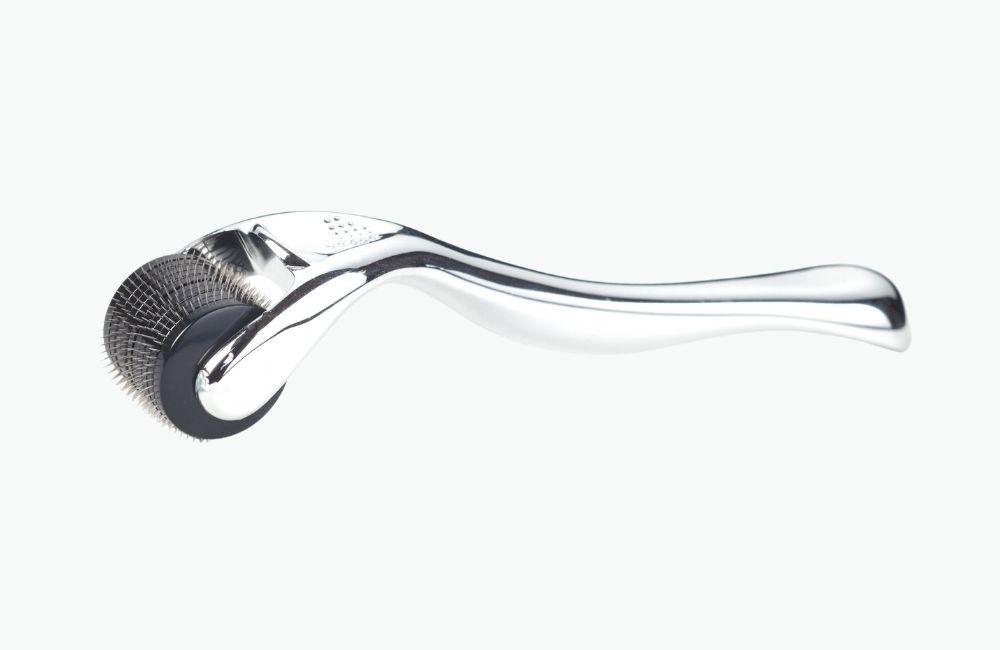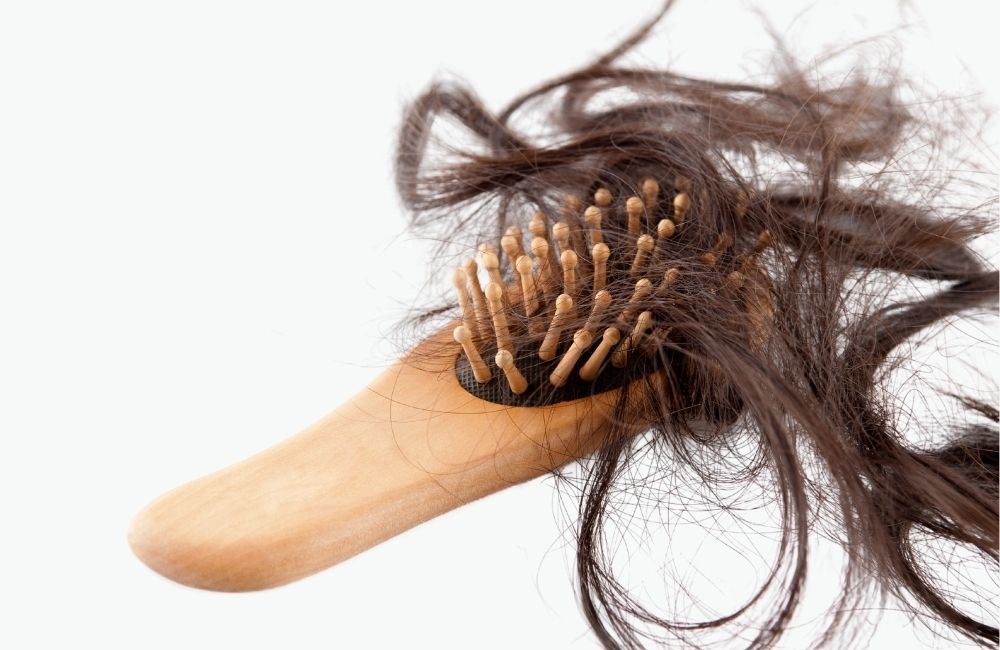Dermaroller for hair loss is getting a lot of good press, and it’s not surprising.
For people who are balding or undergoing rapid hair loss, dermarollers are a good alternative to costly hair loss treatments.
Whether you suffer from hair thinning or you are on the lookout for a new hair loss treatment, you have come to the right place.
If you’re on the fence about getting a dermaroller, here’s all the essential information you need.
Table of Contents
What is a Dermaroller for hair loss?

Let’s go over what dermarollers are before learning how they work.
The dermaroller is a device with hundreds of tiny needles on a small wheel that gently rolls over the scalp skin.
Using this tool, you can perform microneedling, which involves puncturing the scalp’s skin with tiny needles to create wounds that cause new collagen to grow beneath the surface. As a result, it minimizes scarring and hair follicle damage on the scalp and stimulates follicles.
Hair regrowth is triggered by dermarolling for hair loss as it stimulates collagen production within your scalp cells, and new blood vessels are formed in response to the punctures.
Does a dermaroller work for hair regrowth?
Dermarollers for scalp care have grown in popularity in the hair care industry because of their safety.
Many people believe that dermarollers are exclusively for treating skin, however, they have many other uses as well.
Generally, people perform microneedling for hair regrowth and even new hair growth because it effectively penetrates deeper into the skin layers. Moreover, it allows blood vessels and collagen to grow inside the hair shafts, allowing new hair to grow.
Using a dermaroller on the scalp also leaves the scalp feeling refreshed afterward. The results will also keep you coming back for more with this procedure.
How Does Dermaroller Work for Hair Loss?

In layman’s terms, hair follicles are capable of going dormant, so they must be woken up to remain in the active growth stage.
For an understanding of how to prevent hair loss as well as how to grow stronger, denser hair, let’s review the stages of hair growth.
- Anagen phase: The stage when hair cells divide quickly, causing new hair to grow.
- Telogen Phase: The stage when you begin to lose hair. Hair follicles enter a resting phase prematurely, resulting in hair loss.
As your scalp absorbs more nutrients, Dermaroller prevents hair loss during the telogen phase. In this way, you’ll be able to control the loss while keeping it within the usual range of 50-100 strands.
According to a study conducted by the International Journal of Trichology, dermarollers can help produce more hair than just using minoxidil alone. Combining both methods would be an even better option.
Because the tiny needle pricks can help inject the minoxidil into the hair roots deeper, effective treatment for androgenetic alopecia.
Following a derma roller treatment with a hair oil allows your skin to absorb up to 80% of the oil’s nutrients. This compares to 7-10% absorption from a conventional application without a dermaroller.
Another study done in 2021 has shown that dermarollers are a more convenient way of treating hair loss on your scalp. Compared with intradermal scalp injections, rollers provide an equivalent result, along with the benefit of being less painful.
Another recent study was conducted by the Journal of Cosmetic Dermatology on microneedling in different types of alopecia. Results showed that the scalp areas that were most adversely affected by androgenetic alopecia slightly improved.
Together, these studies suggest that microneedling is an effective treatment for hair loss. The procedure is especially effective in treating patches of hair loss on the scalp that are quite extensive.
Benefits of Dermaroller for hair loss
- No pain or discomfort while using
- You don’t have to inject minoxidil in the morning and at night
- Defends against male pattern baldness
- Boosts collagen production in the scalp
- Fastens the growth of hair
- Only takes a little time
- Extra effective when combined with topical minoxidil and other treatments
- Circulates blood around the scalp
- Effective on a budget
- Strengthens hair
- Minimal side effects, most commonly mild irritation or flaking after use
Dermaroller for hair loss before and after results are promising, as they can be seen relatively quickly after regular treatments.

How to Use a Derma Roller on Your Scalp for Hair Growth
At home, you can easily perform the dermaroller hair growth treatment.
If you have an infection or are taking corticosteroid treatment, do not perform the procedure.
- Prep! A clean scalp is a foundation for a successful treatment. Rinse your dermaroller in rubbing alcohol to sterilize it.
- Get rid of knots in your hair by using a wide-tooth comb. With knot-free hair, the derma roller can cover your entire scalp.
- Separate your hair into sections and use the derma roller on one section at a time.
- In all directions, gently roll the derma roller over each part of the section ten times – horizontally, vertically, and diagonally.
- After dermarolling your hair, serum or oil will enhance the effectiveness of the treatment.
Allow a week to pass between using this treatment and healing the wounds.
How long does it take to see results?
The results of dermarollers take about 6 months to manifest, but results can vary based on how early you start the process.
In the early stages of hair loss, you can see results quite quickly. For instance, scalp rolling once a week followed by a topical treatment will show results in the first few weeks.
You may want to give dermarolling a try first to see if it’s right for you.
Side effects of microneedling scalp
Typical side effects include temporary localized redness, bleeding, and inflammation.
Rarely, microneedling can cause the formation of blood blisters or skin tags. While these are only severe conditions, there is very little risk of infection and serious complications are extremely rare.
Other possible side effects include allergic reactions, infections, bumps or irritation around the treatment area. Washing gently can usually avoid or minimize bumps.
Generally, side effects are short-lived and resolve within a week.
The initial touch of the dermaroller may cause a transient stinging sensation. Try to remain calm throughout treatment.
FAQs about Dermaroller for Hair Loss
What’s the best dermaroller size for hair loss?
Needles should always be between 0.25 mm and 1.5 mm in size, but the size is entirely dependent on the needs of your scalp.
If your skin has never been exposed to any of this before, it might be safer to start with a dermaroller with a needle size of 0.5 mm.
Slowly increase the size of the needles up to about 2 mm once your scalp becomes accustomed to these little pricks.
What hair loss treatments can I use along with a Dermaroller?
Derma rolling can be combined with a variety of topical solutions.
After dermarolling, it is recommended to apply a cold-pressed oil to your scalp, so that it can penetrate further to do its job.
Combining several scalp creams and serums will help you grow healthy, long hair.
Can I use the Dermaroller everyday?
An easy-to-use device, the Dermaroller can be used at home or at your desk. However, you shouldn’t keep using it until you see better results.
Dermaroller isn’t for everyday use. We recommend it twice a week. This way, you won’t irritate your scalp too much.
How often should you use a Dermaroller for hair loss?
Do not derma roll more often than twice a week. You should only treat your problem areas once in a single treatment. Repeatedly going over the scalp could result in more injury and infection.
The takeaway
As it can be seen, a dermaroller lets you microneedle your scalp for healthy hair.
The first thing you should do before purchasing a dermaroller for hair loss is to look into what you need to do in order to maximize its benefits.
Yes, the dermaroller may help your hair if it is in the early stages of hair loss.